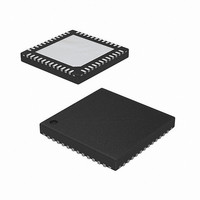ISL6265AHRTZ-T Intersil, ISL6265AHRTZ-T Datasheet - Page 20

ISL6265AHRTZ-T
Manufacturer Part Number
ISL6265AHRTZ-T
Description
IC CTRLR MULTI-OUTPUT 48-TQFN
Manufacturer
Intersil
Datasheet
1.ISL6265AHRTZ.pdf
(23 pages)
Specifications of ISL6265AHRTZ-T
Applications
Controller, AMD SVI Capable Mobile
Voltage - Input
5 ~ 24 V
Number Of Outputs
3
Voltage - Output
0.5 ~ 1.55 V
Operating Temperature
-10°C ~ 100°C
Mounting Type
Surface Mount
Package / Case
48-TQFN
Lead Free Status / RoHS Status
Lead free / RoHS Compliant
Available stocks
Company
Part Number
Manufacturer
Quantity
Price
Company:
Part Number:
ISL6265AHRTZ-T
Manufacturer:
HONEYWELL
Quantity:
100
Part Number:
ISL6265AHRTZ-T
Manufacturer:
INTERSIL
Quantity:
20 000
compared to the switching frequency, the output filter limits
the system transient response. The output capacitors must
supply or sink load current while the current in the output
inductors increases or decreases to meet the demand.
The duty cycle of an ideal buck converter is a function of the
input and the output voltage. This relationship is written as
Equation 17:
The output inductor peak-to-peak ripple current is written as
Equation 18:
For this type of application, a typical step-down DC/DC
converter has an I
output load current. The value of I
several criteria such as MOSFET switching loss, inductor core
loss, and the resistive loss of the inductor winding. The DC
copper loss of the inductor can be estimated by Equation 19:
Where I
The copper loss can be significant so attention must be given to
the DCR selection. Another factor to consider when choosing
the inductor is its saturation characteristics at elevated
temperature. A saturated inductor could cause destruction of
circuit components as well as nuisance OCP faults.
A DC/DC buck regulator must have output capacitance C
into which ripple current I
a corresponding ripple voltage V
sum of the voltage drop across the capacitor ESR and of the
voltage change stemming from charge moved in and out of
the capacitor. These two voltages are written as shown in
Equation 20:
and Equation 21:
If the output of the converter has to support a load with high
pulsating current, several capacitors will need to be paralleled
to reduce the total ESR until the required V
The inductance of the capacitor can cause a brief voltage dip
if the load transient has an extremely high slew rate. Capacitor
ESL can significantly impact output voltage ripple. Low
inductance capacitors should be considered. A capacitor
dissipates heat as a function of RMS current and frequency.
Be sure that I
capacitors so that they operate below the maximum rated
RMS current at F
a capacitor can degrade as much as 50% as the DC voltage
across it increases.
V
D
I
P
ΔV
P-P
COPPER
C
=
ESR
=
---------
V
=
V
-----------------------------
8 C
IN
O
V
----------------------------- -
•
LOAD
=
O
f
I
SW
O
•
I
PP
=
PP
(
•
1 D
f
I
P-P
•
SW
–
LOAD
is the converter output DC current.
•
L
E
SR
)
is shared by a sufficient quantity of paralleled
SW
P-P
2
. Take into account that the rated value of
•
DCR
of 20% to 40% of the maximum DC
P-P
can flow. Current I
20
P-P
P-P
across C
is selected based upon
P-P
O,
is achieved.
P-P
which is the
develops
(EQ. 21)
(EQ. 17)
(EQ. 19)
(EQ. 20)
(EQ. 18)
O
ISL6265A
Selection of the Input Capacitor
The input capacitors are responsible for sourcing the AC
component of the input current flowing into the upper
MOSFETs. Their RMS current capability must be sufficient to
handle the AC component of the current drawn by the upper
MOSFETs, which is related to duty cycle and the number of
active phases.
The important parameters for the bulk input capacitance are
the voltage rating and the RMS current rating. For reliable
operation, select bulk capacitors with voltage and current
ratings above the maximum input voltage and capable of
supplying the RMS current required by the switching circuit.
Their voltage rating should be at least 1.25x greater than the
maximum input voltage, while a voltage rating of 1.5x is a
preferred rating. Figure 11 is a graph of the input RMS ripple
current, normalized relative to output load current, as a
function of duty cycle for a single-phase regulator that is
adjusted for converter efficiency.
The normalized RMS current calculation is written as
Equation 22:
Where:
Figure 12 provides the same input RMS current information
for two-phase designs.
In addition to the bulk capacitance, some low ESL ceramic
capacitance is recommended to decouple between the drain
of the high-side MOSFET and the source of the low-side
MOSFET.
I
IN_RMS N
- I
- I
- D is the duty cycle that is adjusted to take into account
- where η is converter efficiency
D
FIGURE 11. NORMALIZED RMS INPUT CURRENT FOR
to I
the efficiency of the converter which is written as:
0.60
0.55
0.50
0.45
0.40
0.35
0.30
0.25
0.20
0.15
0.10
0.05
MAX
PP,N
=
0
MAX
----------------- -
V
,
0
IN
is the maximum continuous I
V
is the ratio of inductor peak-to-peak ripple current
O
=
I
⋅
P-P,N
0.1
η
D
= 1
SINGLE PHASE CONVERTER
⋅
0.2
(
1 D
–
0.3
)
DUTY CYCLE (V
+
⎛
⎝
I
P-P,N
----- -
12
0.4
D
⎞ I
⎠
⋅
= 0
0.5
I
PP N ,
P-P,N
I
P-P,N
= 0.25
0.6
2
= 0.50
IN/
LOAD
V
O
0.7
)
of the converter
I
P-P,N
0.8
= 0.75
(EQ. 23)
May 11, 2009
0.9
(EQ. 22)
FN6884.0
1.0












